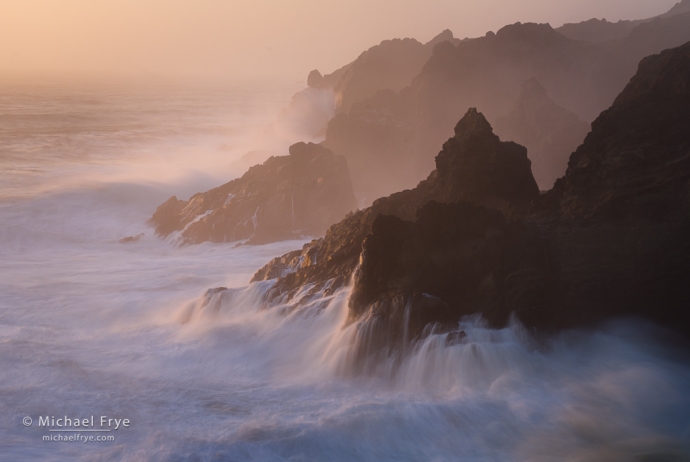
Misty evening light along the Oregon coast. I thought a slow shutter speed (1 second) complemented the soft, misty, painterly light in this scene.
If you want to make expressive photographs – ones that capture a mood, or tell a story – then light, composition, and timing (the moment you capture) are usually the most powerful tools in your arsenal. Those three essential elements largely define the message and feeling of a photograph.
But while these tools are vital, they’re not the only ones at our disposal. We also have camera controls, like shutter speed, aperture, and filters. And we can use processing to interpret and enhance the photograph’s message.
Shutter speed is, of course, one of the primary means of controlling exposure – how much light reaches the film or sensor. And it also affects the sharpness of hand-held photos.
But let’s assume for a second that you’re using a tripod, and something in the scene is moving. In that case, your choice of shutter speed will change the way the photo conveys the sense of motion – whether the moving object is “frozen” or blurred. And that shutter-speed decision also can have a big effect on the mood and message of the image. Blurring moving objects with a slow shutter speed can make the image look and feel softer – more impressionistic, ethereal, or even romantic. Freezing motion with a fast shutter speed can make the photograph crisper, harder, and, in some cases, more dramatic.
So before deciding what shutter speed to use, I think you first have to ask yourself what story you’re trying to tell, and what feeling you want to convey.
I made the photograph at the top of this post during our recent redwoods workshop, as big waves crashed against a rocky shore. We were happy to see those large swells, as seas in this area are typically rather placid in June.
I made many exposures with fast shutter speeds, freezing the spray of some big wave splashes. But late in the afternoon the hazy/misty atmosphere grew thicker, softening the light, and creating beautiful pastel colors. I remarked to our group that it looked rather painterly.
To me, the mood had changed, and I thought that the softness created by a slow shutter speed would better complement the softer, more painterly light, and enhance the new, more ethereal mood that light created. It’s not that a fast shutter speed couldn’t also convey that mood; I just felt that a slow shutter speed would help push the feeling of the image further in the direction it wanted to go.
So I put on a neutral-density filter (seven stops at first), and tried to dial in the right shutter speed. Four seconds, and even two seconds, looked too soft – the waves didn’t have enough definition. So I switched to a less-strong ND filter (four stops). One-and-a-half seconds looked better, and one second better still. Faster than that, however, and the water had too much definition and texture; it wasn’t soft enough for the mood I wanted to convey.
So I stuck with one second, and fired off frame after frame as waves splashed and receded. Some of the best moments with that one-second shutter speed came when a wave poured off a rock, creating a waterfall effect. The photograph above actually has both a splashing wave (in the distance) and a receding wave (in the foreground) in the same frame.
The next morning we rose (way too) early and went to an overlook, with fog streaming out from the mouth of a river. This was our third attempt that week at finding the right fog at this spot; the first time there wasn’t enough fog, the second time everything was completely socked in, but the third morning was just right.
I started off using very-slow shutter speeds (10 to 30 seconds) to blur the motion of not just the water, but the streaming fog. Then the sun rose higher and started to break through the fog and light the breaking waves.
That changed the equation. What caught my eye, what seemed most striking to me at the time, was the succession of curving, white, breaking waves lit by the sun. Slow shutter speeds blurred those waves and smushed them into a big white blob. Maybe something slowish, like 1/4 or even 1/2 sec., could have preserved the shapes and lines of the waves, but at that distance those would be “in-between” shutter speeds, where the water isn’t really blurred, but isn’t really sharp either. So I opted to make the shutter speed fast enough to truly freeze the motion. In this case, with the water moving relatively slowly across the frame, 1/125 sec. was enough. And again, It took many frames to catch the right moment, with good spacing, separation, and repetition in the wave pattern:
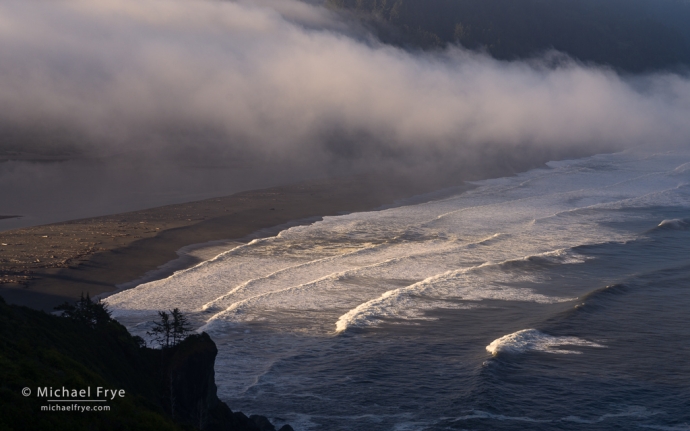
Sun breaking through fog along the northern California coast. Here I needed a fast shutter speed (1/125 sec.) to preserve the shape of the waves, and the repetition created by their successive lines – an important part of the story in this image.
In this scene the light provided contrast and drama, and the fast shutter speed not only preserved the repeating lines of the waves – an important part of the story – but also, I think, enhanced the drama more than a slow shutter speed would have.
When you see an opportunity to make an expressive photograph, you want to use every tool at your disposal to enhance its message. Those tools always include light, composition, and the moment you capture, but sometimes camera controls can also play key roles. If something in the frame is moving, think about how you can use the shutter speed to control not just how that object looks, but how its appearance affects the story and mood of the image.
I’ve posted more ocean photographs from our trip to the redwoods below, with extended captions that include notes about the shutter speeds.
— Michael Frye
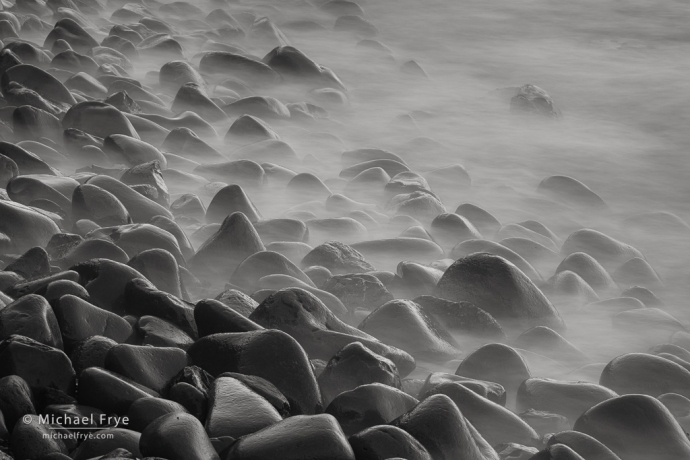
Rocks along the Pacific coast, northern California. Here I opted for a 30-second exposure to make the water ethereal and misty-looking, and make it seem as if the rocks were floating on a cloud.
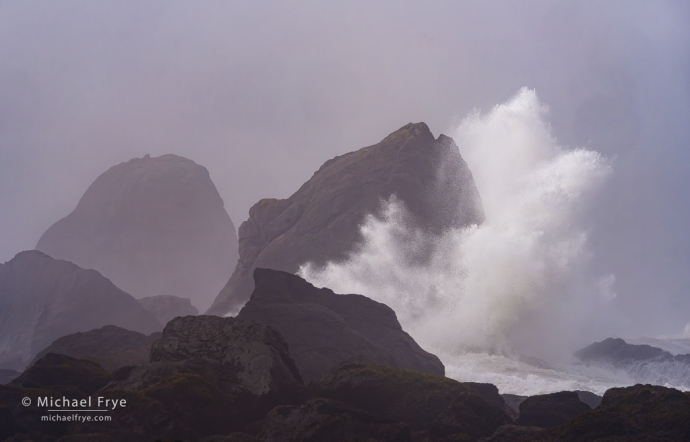
Rocks and crashing wave, northern California. I chose a fast shutter speed here (1/350 sec.) to freeze the motion and capture the shape and texture of the wave.
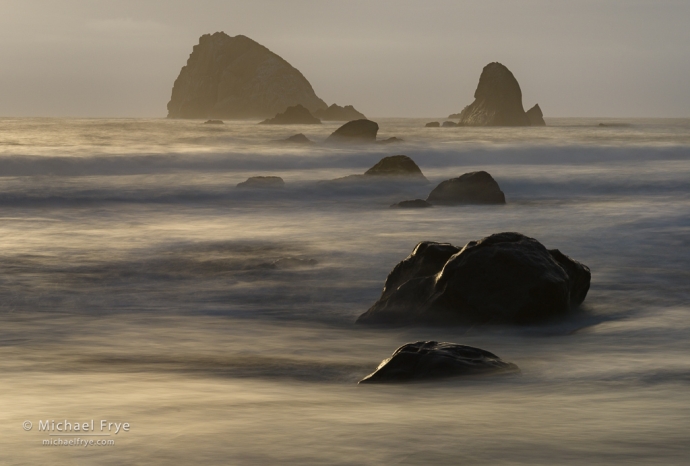
Late-afternoon light on rocks and the Pacific Ocean, Redwood NP, California. In this scene I think a fast shutter speed could have worked also, but I decided to go slower (4 seconds) to soften the water and create a textural contrast between the soft water and hard rocks. But I didn’t want the shutter speed to be too slow, as I wanted to preserve the successive lines of the waves. As always, it took many attempts to get the right wave pattern.
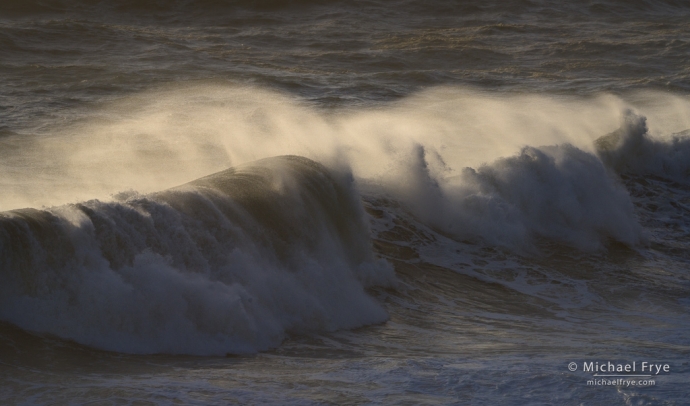
Wind-blown wave, Pacific Coast, Oregon. I made this photograph earlier on the same evening as the one at the top of this post. Here I used a long lens to focus on some of the big breakers rolling in, trying to capture the beautiful backlit spray blowing off the tops of the waves, and opted for a fast shutter speed (1/750 sec.) to freeze the motion and preserve the shape and texture of the spray.
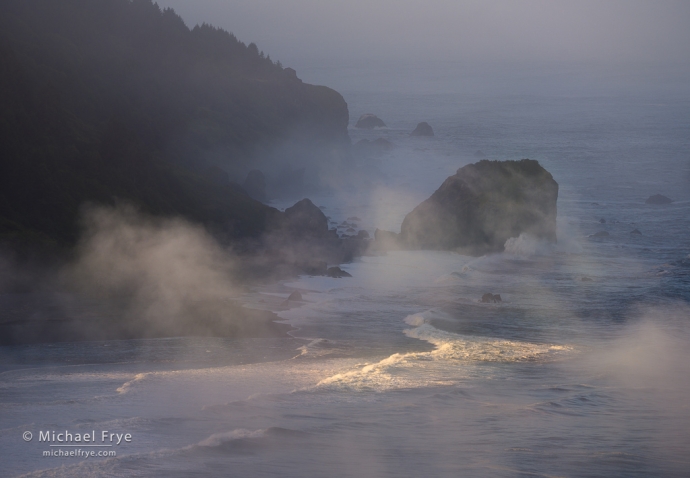
Waves, fog, and rocky coast, Northern California. Made on the same morning as the second photograph above, and again I chose a fast shutter speed (1/125 sec.) to preserve the shape of the sunlit waves.
Related Posts: Waves and Slow Shutter Speeds; Ocean Moods
Michael Frye is a professional photographer specializing in landscapes and nature. He lives near Yosemite National Park in California, but travels extensively to photograph natural landscapes in the American West and throughout the world.
Michael uses light, weather, and design to make photographs that capture the mood of the landscape, and convey the beauty, power, and mystery of nature. His work has received numerous awards, and appeared in publications around the world. He’s the author and/or principal photographer of several books, including Digital Landscape Photography: In the Footsteps of Ansel Adams and the Great Masters, and The Photographer’s Guide to Yosemite.
Michael loves to share his knowledge of photography through articles, books, workshops, online courses, and his blog. He’s taught over 200 workshops focused on landscape photography, night photography, digital image processing, and printing.









Beautiful images, Michael! I enjoy hearing about and seeing your photos taken using different shutter speeds. Always a joy photographing the ocean in its many different moods.
Wonderful images! I especially like the way the water is flowing in the first image on the Oregon coast. Seeing these take me back to the Mystic Forest workshop last year…such a beautiful area for landscape work. Looks like you had another great trip!
Great sequence of shots with the various shutter speeds. Thanks for the great description of what you were after.
Thanks Paul! Glad you found that helpful.
Great piece. It starts out with some basic principles (reminders for many) and then you explain the multiple approaches can create. Good piece for beginners thru more advanced photographers who know the skills and are encouraged to think about a variety of approaches
Thanks very much Randy! I love working with different shutter speeds along the coast, so I hope this encourages people to experiment more with this.
Beautiful misty evening photograph! The chosen shutter speed definitely conveyed the mood. Thanks, Michael.
Thanks so much Rob!